Thinking of working in the Philippines? If you’re looking to grow your career or find new opportunities, it’s important to know about work visa requirements. How can you get a work visa and smoothly adapt to the Philippines’ lively culture and rich history?
This guide will show you how to get a work visa in the Philippines. We will cover the Alien Employment Permit (AEP) and the Pre-arranged Employment Visa. You’ll learn about different visa types, what you need for each, and how long they last. This info will help you understand the application steps and pick the right visa for you.
Key Takeaways:
- Foreign nationals planning to work in the Philippines need to secure a work visa and an Alien Employment Permit (AEP).
- There are different types of work visas available, each with its own set of requirements and validity period.
- The Alien Employment Permit (AEP) authorizes a foreign national to work in the Philippines.
- The Pre-arranged Employment Visa (9[G] Visa) is the most common type of work visa issued in the Philippines.
- Other visa types in the Philippines include the Treaty Trader’s Visa (9[D] Visa) and various specialized visas.
Understanding the Alien Employment Permit (AEP)
The Alien Employment Permit (AEP) is a key requirement for foreigners wanting to work in the Philippines. It lets them legally work and follows labor laws. Knowing about the AEP is key for a smooth work visa application.
The AEP lasts for one year or until the employment contract ends, whichever comes first. The contract can’t be more than three years. This permit covers various jobs, from professional to non-skilled roles, with some conditions.
Some foreign nationals don’t need an AEP. These are diplomats, foreign government officials, and permanent residents. They follow different rules based on their situation.
The AEP is different from the work visa. It allows work, but a valid visa is needed to enter and stay in the Philippines for work.
For a successful AEP application, know and follow the work visa rules in the Philippines. You’ll need a valid passport with a visa, your employment contract, and the mayor’s or business permit.
In brief, the AEP is crucial for foreign workers in the Philippines. It gives them work authorization and ensures they follow labor laws. While some don’t need an AEP, most foreigners do. With the right knowledge and steps, foreign workers can legally work in the Philippines.
AEP Application Requirements
| Document | Description |
|---|---|
| Application Form | A completed AEP application form downloaded from the Bureau of Immigration website. |
| Passport with Visa | A photocopy of the applicant’s passport with a valid work visa for the Philippines. |
| Employment Contract | All documents related to the employment contract, including terms and conditions, salary details, and job description. |
| Current AEP (in cases of reissue) | A photocopy of the current AEP, if applicable. |
| Mayor’s Permit or Business Permit | A photocopy of the mayor’s permit or business permit from the local government unit where the employer is based. |
Applying for an Alien Employment Permit (AEP)
If you plan to work in the Philippines, the first step is getting an Alien Employment Permit (AEP). This permit is for foreigners who want to work in the country. The Department of Labor and Employment (DOLE) issues it.
For a successful AEP application, you need to collect some documents:
- Completed application form
- Photocopy of your passport with a valid visa
- All documents related to your employment contract
- Photocopy of your current AEP (in cases of reissue)
- Photocopy of the mayor’s permit or business permit
These documents help check if you can work in the Philippines. Make sure you have everything before applying.
Your employer or you can apply for the AEP. If your employer does it, give them all the documents and information they need.
After submitting, DOLE reviews your application and processes your AEP. As processing times can change, apply early to start working without delays.
Remember, getting an AEP is key to legally work in the Philippines. Follow the application steps well and submit all required documents for a smooth process.
Key Takeaways:
- Applying for an Alien Employment Permit (AEP) is necessary for foreigners to work in the Philippines.
- Required documents include an application form, passport copy, employment contract details, current AEP copy, and mayor’s permit.
- The AEP can be applied for by the employer or the individual.
- Prepare all documents ahead to avoid application delays.
- Processing times vary, so apply in advance.
The Pre-arranged Employment Visa (9[G] Visa)
The 9[G] Visa is the most common work visa in the Philippines. It lets foreign workers live and work there for a while. The length of stay depends on their job contract.
To apply for this visa, one must first get an Alien Employment Permit (AEP). The AEP is needed for the visa application. It ensures the job follows the Philippines’ labor laws.
After getting the AEP, it’s time to apply for the 9[G] Visa. This step includes presenting important documents like a passport and a medical certificate. An interview and extra papers might also be needed.
Getting a 9[G] Visa is vital for those wanting to work in the Philippines. It allows them to work legally and enjoy worker benefits.
The 9[G] Visa is usually valid for one to three years. It can be renewed as long as the job contract is still good.
Those with a 9[G] Visa can get a Philippine ID (PHILID). With it, they can open a bank account, join insurance programs, and use health services.
Applying for the 9[G] Visa includes many steps. It’s best to talk to an immigration lawyer or contact a Philippine embassy for help.
Benefits of the Pre-arranged Employment Visa (9[G] Visa)
The 9[G] Visa offers several benefits for foreign workers in the Philippines:
- Legal permission to work and reside in the Philippines for the duration of the employment contract
- Access to benefits and protections granted to workers in the country
- Eligibility to apply for a Philippine Identification Card (PHILID)
- Opportunity to open a bank account, enroll in insurance programs, and access healthcare facilities
- Possibility of renewing the visa multiple times
Applying for a Pre-arranged Employment Visa (9[G] Visa)
If you’re a foreigner planning to work in the Philippines, you’ll need a 9[G] Visa. It’s vital to meet all the Philippine Bureau of Immigration’s requirements for a smooth process. Here is a list of documents and qualifications you must have:
Required Documents for a 9[G] Visa Application
- A notarized certification showing the number of foreign and Filipino employees.
- The completed Pre-arranged Employment Visa application form.
- A report from a medical and physical exam by an accredited clinic or hospital.
- A signed copy of the employment contract, by both employer and employee.
- Passport-sized pictures, usually with a white background.
- Police clearance or a document proving your good conduct.
- Other necessary documents, like educational and professional certifications, or work experience proof.
The needed documents can change based on your home country and the job. Always check with the nearest Philippine Embassy or Consulate for the latest information.
The Visa Application Process
Applying for the 9[G] Visa involves several steps, including possibly an interview and providing more documents. Follow the Bureau of Immigration’s instructions closely and stick to the timeline provided.
“Getting a pre-arranged employment visa takes careful planning and paying attention to details. Make sure all documents are correct and meet all requirements to improve your chances of a successful application.”
When your 9[G] Visa is approved, you will get an entry visa. This lets you legally enter the Philippines. Remember to follow all visa rules, including how long it’s valid for and any extra requirements from the Bureau of Immigration.
The Treaty Trader’s Visa (9[D] Visa)
The Treaty Trader’s Visa, known as the 9[D] Visa, is for people from countries with trade agreements with the Philippines. Countries like the United States, Japan, and Germany are included. This visa lets individuals trade greatly between their homeland and the Philippines for up to two years.
Are you trading a lot between your country and the Philippines? The Treaty Trader’s Visa (9[D] Visa) might be perfect for you. It lets you work and stay long-term in the Philippines. This kind of visa helps increase trade and economic relations between countries.
Benefits of the Treaty Trader’s Visa:
- Long-term stay in the Philippines for up to two years
- Flexibility to engage in substantial trade activities
- Opportunity to establish and expand business connections in the Philippines
- Enhanced access to economic opportunities and markets
Getting the Treaty Trader’s Visa helps you use the trade agreement between your country and the Philippines. It’s great for entrepreneurs, investors, or traders. This visa creates many new opportunities and partnerships.
“The Treaty Trader’s Visa allows businesspeople to foster international trade relations and contribute to the economic development and prosperity of both their home country and the Philippines.”
To get the Treaty Trader’s Visa (9[D] Visa), you must show proof of heavy trade with the Philippines. You need to show a big investment and a plan to leave after work is done.
Note: It is important to consult with the relevant Philippine government agencies or seek professional advice to ensure you meet all the requirements and understand the application process thoroughly.
Applying for a Treaty Trader’s Visa (9[D] Visa)
Foreign nationals can apply for a Treaty Trader’s Visa, or a 9[D] Visa, for business in the Philippines. This visa lets people work there for two years. To get it, you must follow the Philippines Bureau of Immigration’s rules.
To get a 9[D] Visa, show you or your employer trades a lot between your country and the Philippines. You’ll need to provide evidence like business deals and trade agreements. Financial statements should also show your trading activities.
You must also prove that you plan to leave the Philippines after your work is done. You can do this with return tickets or proof of business in your home country.
You need to be the same nationality as your employer or the company’s main shareholder in the Philippines. This is to stick to the trade agreement between the two countries.
To qualify for a 9[D] Visa, you must be a supervisor or executive. This ensures you play a key role in the company’s trade.
Make sure to check the Philippines Bureau of Immigration’s detailed requirements. It’s wise to talk to an immigration lawyer or expert to help with your application.
Requirements for Treaty Trader’s Visa (9[D] Visa)
| Requirement | Description |
|---|---|
| Engagement in Substantial Trade | Provide evidence of substantial trade activities between the country of origin and the Philippines |
| Intention to Leave | Demonstrate plans to depart the Philippines upon completion of the work contract |
| Same Nationality | Hold the same nationality as the employer or major shareholder of the company in the Philippines |
| Position of Supervisor or Executive | Hold a supervisory or executive role in the company involved in the trade activities |
Other Visa Types in the Philippines
Other visas in the Philippines include the Special Non-immigrant Visa, Foreign Government Official Visa, and more. These visas are for students, spouses, and those in arts and culture. Each has specific requirements and restrictions. It’s crucial to pick the best one for your needs.
SPECIAL NON-IMMIGRANT VISA
This visa is for those not working but staying for a long time in the Philippines. It suits retirees, investors, or those married to Filipinos. You will need to show money proof, a health certificate, and police clearance.
FOREIGN GOVERNMENT OFFICIAL VISA
Foreign officials on duty get the Government Official Visa. It requires approval from their government. Stay length depends on the duty’s purpose and time.
STUDENT VISA
Foreigners wanting to study in the Philippines need a Student Visa. This is for students accepted into Philippine schools. Applicants must prove they have enough money and a study plan.
SPOUSE VISA
Foreigners married to Filipinos can get a Spouse Visa. This visa lets the spouse live and work in the Philippines. You need a marriage certificate, money proof, and a visa form. The visa lasts as long as the marriage does.
QUOTE VISA
The Quote Visa is for those in arts, culture, and sports. It’s for athletes, artists, and entertainers. You need an invitation, professional proof, and an employment contract.
| Visa Type | Requirements | Restrictions |
|---|---|---|
| Special Non-immigrant Visa | Proof of financial capacity, health certificate, police clearance | Not permitted to work in the Philippines |
| Foreign Government Official Visa | Endorsement from sending government | Subject to diplomatic protocols and agreements |
| Student Visa | Proof of acceptance to a Philippine educational institution, proof of financial capacity, valid study plan | Allowed to study but not permitted to work full-time |
| Spouse Visa | Valid marriage certificate, proof of financial capacity, spouse visa application form | Allows residence and work in the Philippines |
| Quote Visa | Letter of invitation from a Philippine sponsor, proof of professional qualifications, valid employment contract | Specific to arts, culture, and sports activities |
Planning to retire, study, or work in the Philippines? Understanding the different visas is crucial. Each visa has unique requirements. Knowing these helps make moving to the Philippines easier.
Living in the Philippines: Cost of Living and Housing
The cost of living in the Philippines is quite lower than in the United States. Many people find it a great place for a cheaper lifestyle. You can choose from busy cities to calm beach towns, each unique.
Eating out, using public transport, and utilities cost less there. Local restaurants and street food are much more wallet-friendly than in the west.
Housing is a big part of living costs. In cities like Manila or Cebu, renting a one-bedroom in the center is affordable. Still, prices change based on location and what you get.
Cost of Living in the Philippines
Here’s a look at some typical expenses in the Philippines:
- Monthly rent for a one-bedroom apartment in the city center: $300 – $500
- Meal at an inexpensive restaurant: $2 – $5
- Local transportation (bus, jeepney, or train): $0.20 – $0.50
- Utilities (electricity, water, internet): $50 – $100
- Groceries: $100 – $200
These are estimates. Actual costs can differ based on where you are and how you choose to live. It’s wise to look into where you plan to live in the Philippines beforehand.
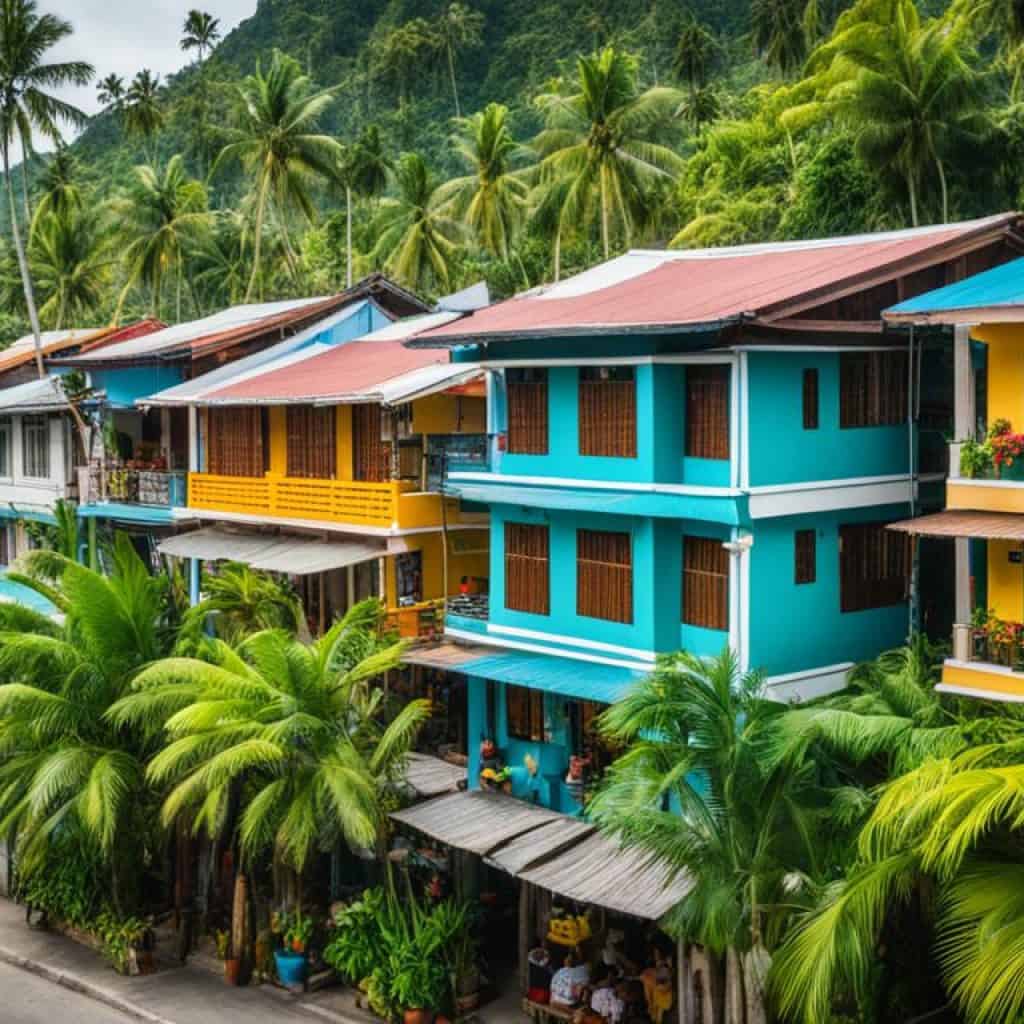
In the Philippines, housing choices fit various budgets and tastes. There are city condos and island beach villas, offering something for everyone.
“The Philippines has many housing options, from affordable apartments to luxury beach homes. Consider location, amenities, and security when picking a place.”
In city centers, you can find apartments and condos with nice amenities like pools and gyms. For a quieter place, look outside the cities. There, houses or townhouses offer more space.
Finding the best housing matches your budget and needs with the help of a good real estate agent or online research.
The cost of living and housing in the Philippines is a great chance for those wanting a budget-friendly life. It’s a place with vibrant culture and natural beauty.
Healthcare and Banking in the Philippines
Before moving to the Philippines, learn about its healthcare and banking. This knowledge is vital.
Healthcare in the Philippines
The country’s public healthcare is not top ranked. It’s wise to get private health insurance. This ensures access to better facilities.
Private healthcare services are diverse. They include hospitals, clinics, and specialists.
“Having private health insurance in the Philippines gives you peace of mind knowing that you have access to quality medical services and facilities when you need them.” – John Smith, Expat living in the Philippines
Private health insurance in the Philippines covers a lot. It includes hospital stays, outpatient care, and emergencies. You get a network of doctors and hospitals to choose from.
Banking in the Philippines
US citizens can open a bank account there. Many banks accept online applications. A local bank account simplifies finance management.
Philippines’ major banks offer several services. These include savings/checking accounts, credit cards, and loans. Online banking is also available for easy account management.
“Opening a bank account in the Philippines was a straightforward process for me as a US citizen. It’s convenient to have a local bank account for day-to-day transactions and access to ATMs.” – Jane Doe, Expat living in the Philippines
ATMs are common in big cities and accept international cards. However, using ATMs from other banks may incur fees. Always check for any fees.
Healthcare and Banking Comparison
| Aspect | Healthcare | Banking |
|---|---|---|
| Quality | Private healthcare offers higher quality facilities and services. | Major banks provide reliable and convenient banking services. |
| Insurance Coverage | Private health insurance plans offer comprehensive coverage. | Bank accounts offer various services, including savings, checking, and online banking. |
| Accessibility | Private healthcare facilities are available in major cities. | ATMs are easily accessible in major cities, but fees may apply. |
Private health insurance and a local bank account are key for peace of mind in the Philippines. Do your research to find the best options for you.
Education in the Philippines
The Philippines education system is modeled after the American one. It includes public and private schools. This gives students and parents many choices, ensuring access to good education for all.
For US students, a big plus of studying in the Philippines is the use of English. It’s the main language for teaching. This means international students can adjust quickly and talk easily with others. The focus on English helps students study without language problems.
In big cities like Manila, there are international schools. They serve expat families. These schools usually use US or other countries’ curricula. This provides a familiar learning environment for students. Also, international schools in the Philippines have a mix of cultures. This lets students meet others from different parts of the world and learn global views.
The school year here usually goes from June to March, like in the US. This makes it easy for US students to join the Philippines’ education system. They can continue their studies smoothly without big changes.
Private and Public Schools in the Philippines
In the Philippines, private and public schools are both important in education.
Private schools are known for high-quality education. They often have modern facilities, smaller classes, and more focus on each student. Many offer international curricula or special programs in fields like science, technology, engineering, arts, and math.
Public schools, however, are run by the government. They provide free education for all Filipinos. These schools follow the national curriculum by the Department of Education (DepEd). They include many subjects across different fields.
Even though private schools have more resources, public schools in the Philippines still aim for high education quality. Both types of schools have teachers who work hard to help their students grow intellectually and personally.
Challenges and Improvements in the Philippine Education System
The Philippine education system faces challenges but is improving in quality and reach.
One issue is the education quality gap between urban and rural areas. Some remote or poor areas lack resources and facilities. The government is working to fix this. They are building schools, improving infrastructure, and giving resources to needy areas.
Updating the curriculum and teaching methods for the modern world is another challenge. Skills like digital literacy and critical thinking are more and more important. The Philippines is reforming education to meet these needs and match global standards.
The COVID-19 pandemic has shown how crucial online learning is. Philippine schools are using online methods to keep education going. This move towards digital schooling has sped up the creation of online learning tools. Now, education is more reachable and flexible.
Comparison of Public and Private Schools in the Philippines
| Aspect | Public Schools | Private Schools |
|---|---|---|
| Cost | Free for Filipino citizens | Tuition fees vary depending on the school |
| Curriculum | National curriculum set by DepEd | Variety of curricula, including international programs |
| Class Size | Varies, larger class sizes | Smaller class sizes, more individualized attention |
| Facilities | Basic facilities provided | Modern facilities and resources |
| Accessibility | Widely available throughout the country | Concentrated in urban areas, limited in remote areas |
Both public and private schools in the Philippines have pros and cons. The country is dedicated to improving its education system. It wants all students to get a good education.
Transportation in the Philippines
Traveling in the Philippines is quite the adventure. Various options are available, depending on where you are and which islands you want to visit. You can explore Manila’s busy streets or the scenic provinces. No matter where you’re headed, there’s a transportation method just for you.
In places like Manila, cheap and convenient ways to get around are everywhere. Buses, jeepneys, and taxis are commonly used. Buses help you travel far distances in the city cheaply. Jeepneys, which are colorful and unique, give you a cultural experience. Taxis are great for shorter trips or if you have lots of luggage.
“Discover the unique charm of the Philippines through its colorful jeepneys, the country’s iconic mode of public transportation.”
For island explorers, flights and ferries are great for traveling between islands. The Philippines has over 7,000 islands, so flying can be the fastest way to get around. Local airlines link major cities to tourist spots, making island hopping easy. Ferries are good too, especially to places planes don’t go. They offer beautiful views and a chance to see the Philippines’ beauty.
Driving in the Philippines is not usually suggested for tourists or expats. The roads are often busy, and traffic can be unpredictable. The quality of roads also varies. However, if you choose to drive, learn the local traffic rules first. For ease, consider renting a car with a driver.
Transportation options in the Philippines fit any preference or budget. You can enjoy local culture on a jeepney, see the islands from a plane or ferry, or take taxis for convenience. Traveling here is an exciting part of your Philippines adventure.
Cost of Moving to the Philippines
Moving to the Philippines is an exciting adventure. It’s crucial to think about the costs involved in relocating. This includes shipping your things, buying plane tickets for your family, and sometimes, moving pets.
The expense of shipping depends on how much you’re sending and where it’s going. Getting quotes from shipping companies can give you a clearer idea of the cost. Planning your budget carefully makes moving easier.
| Expense | Estimated Cost |
|---|---|
| Shipping Furniture and Belongings | $1,500 – $5,000 |
| Flights for Family Members | $800 – $2,000 per person |
| Pet Transportation | $500 – $2,000 per pet |
Remember, these costs are just estimates and can change. Factors like how much you’re taking, who’s traveling, and pet needs affect costs. Talking to shipping companies and airlines will help get exact figures.
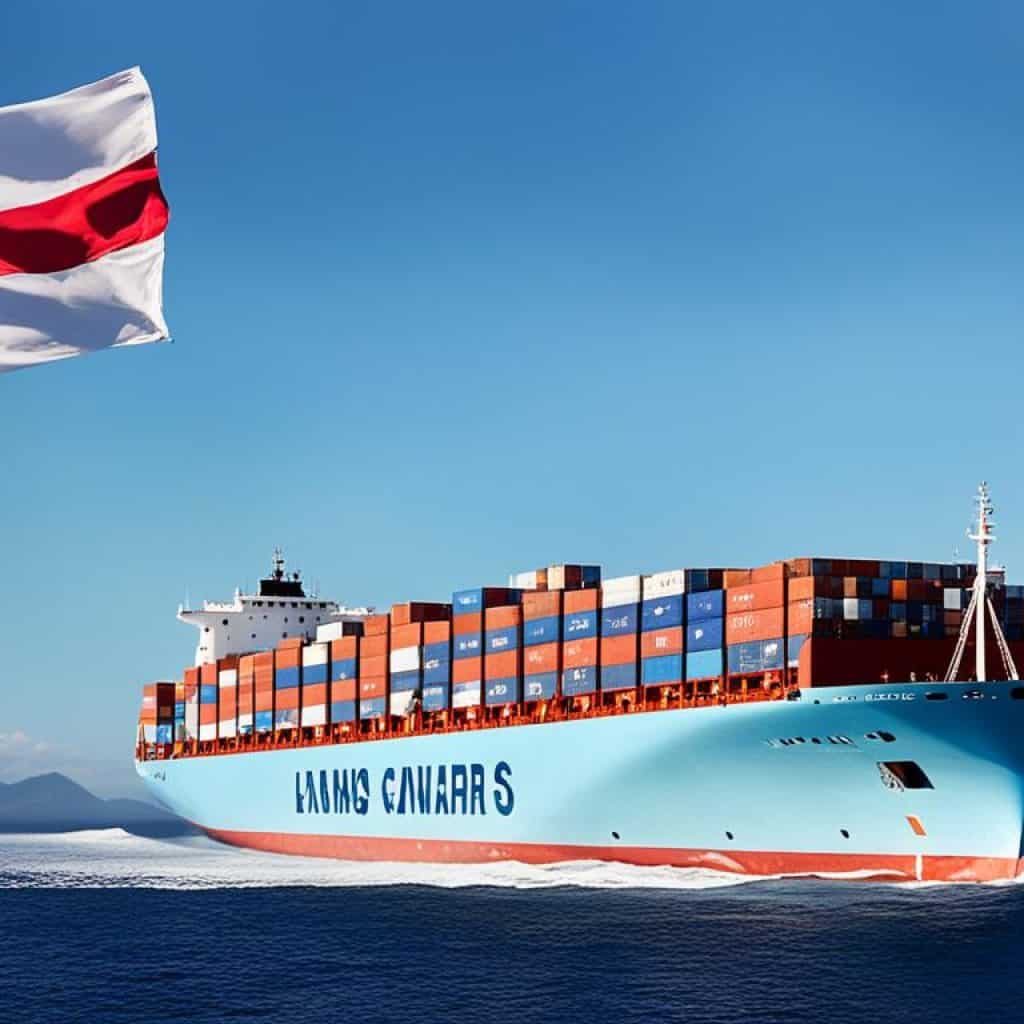
It’s vital to plan and budget for your move to the Philippines. Considering things like shipping costs, plane tickets, and moving pets aids in financial preparation.
Using Wise for International Transfers to the Philippines
Need to send money between the US and the Philippines? Wise is your top choice. It offers mid-market rates and low fees for transfers.
With a Wise Account, you can hold and exchange many currencies. This includes the Philippine peso. There are no minimums or monthly fees.
This flexibility lets you manage your money easily, even across borders.
Wise makes transferring money simple. Plus, you can get a Wise card. With it, spend in the Philippines just like you’re local. Whether it’s shopping or withdrawing cash, the Wise card gives you access to your money anytime, anywhere.
Choose Wise for easy and cost-effective transfers to the Philippines. Enjoy the convenience and savings Wise brings to your money transfers.
Next, we will take a closer look at the key considerations for managing your money in the Philippines.
Conclusion
It’s vital to know the right work visa and permit for moving to the Philippines. You could need an Alien Employment Permit, Pre-arranged Employment Visa, or Treaty Trader’s Visa. Check the specific needs for each.
Also, learn about living costs, homes, healthcare, and banks in the Philippines. This makes moving there easier.
Using Wise is a smart way to handle money there. Wise has good exchange rates and low fees. You can hold many currencies in a Wise Account.
There’s no need to keep a minimum balance or pay monthly fees. And with the Wise card, spending in the Philippines is easy. This helps with money matters.
Understanding visa needs and smart money management improves your stay in the Philippines. Enjoy its culture, beauty, and friendly people. Make the most of your adventure.
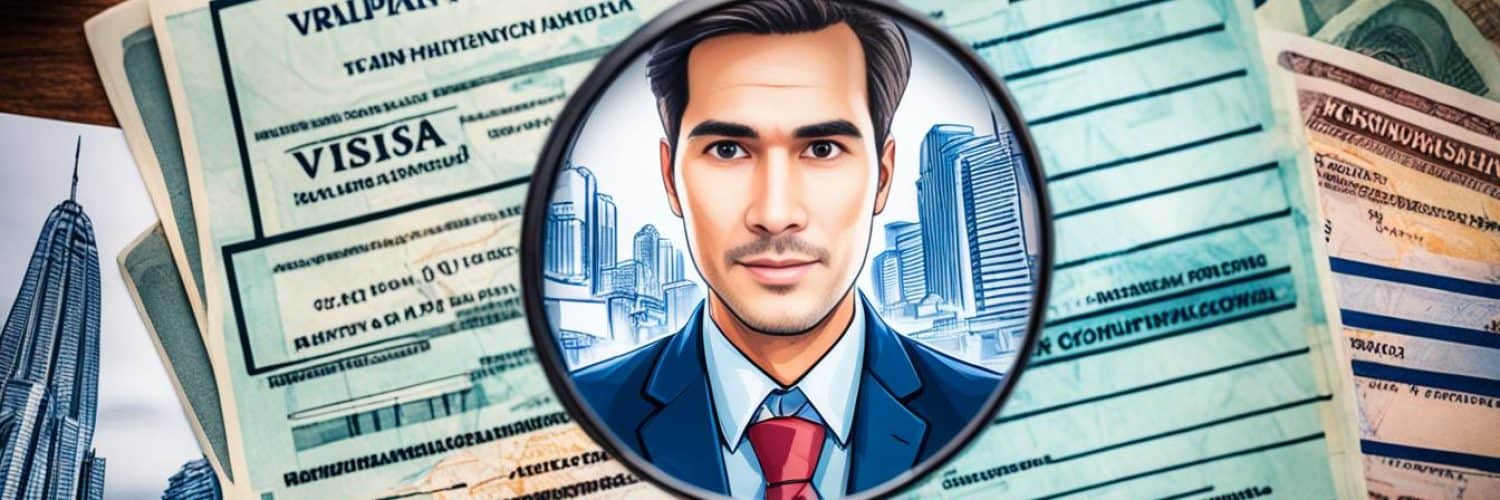
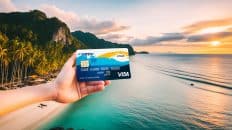
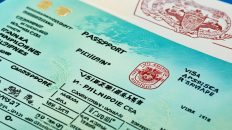
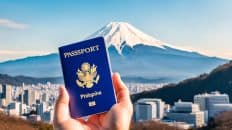














Add comment